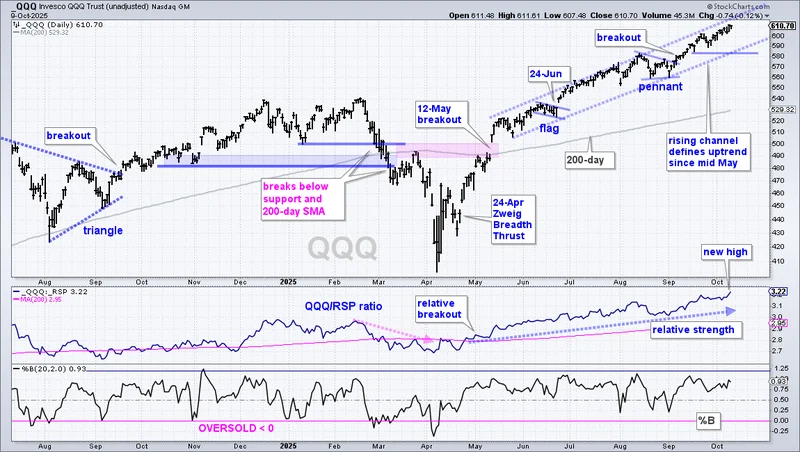It’s Monday morning. Across the country, thousands of screens flicker to life, casting a green glow in otherwise dark rooms. The numbers on the futures ticker for the Nasdaq-100 are climbing. Up 1.5%, then 1.8%, almost a full 2%. The SPDR S&P 500 ETF (SPY) is up too, but the tech-heavy Invesco QQQ Trust (QQQ) is leading the charge. The collective sigh of relief from investors is almost audible after a brutal Friday session.
The catalyst? A weekend post on Truth Social from Donald Trump, of all things. After threatening a 100% tariff on Chinese imports and sending markets into a tailspin, he reversed course with a characteristically blunt message: “Don't worry about China, it will all be fine!” Just like that, the algorithmic tripwires were reset from “risk-off” to “risk-on.”
This is the modern market in miniature. A system of immense complexity, swayed in the short term by geopolitical whims and 280-character pronouncements. And at the center of this gyre sits the QQQ, an exchange-traded fund that has become less of an investment vehicle and more of a barometer for market sentiment itself. It tracks the 100 largest non-financial companies on the Nasdaq, which means it’s effectively a bet on American innovation. But right now, the data surrounding it is telling two very different stories.
The Narrative Engine
On the surface, the case for the QQQ is almost seductively simple. It’s the easiest way to get exposure to the artificial intelligence boom. The fund’s top holdings are dominated by the "Magnificent Seven," which represent a significant portion of its weight—44% to be exact. Owning QQQ means you own the companies building the AI infrastructure, from Nvidia’s chips to Microsoft’s cloud services. For the average investor, it’s a one-click solution to participate in what’s being sold as the next industrial revolution, and it's why some analysts have dubbed it The Smartest AI ETF to Buy With $1,000 Right Now.
This narrative has been incredibly powerful. The fund’s trailing 10-year total return is over 500%. An investment of $1,000 in October 2015 would be worth more than $6,200 today. It’s the kind of performance that creates true believers, and it attracts capital like a magnet.
Institutional money, the so-called "smart money," appears to be buying into this story with conviction. Recent 13F filings show a feeding frenzy. Greenwood Gearhart Inc. boosted its stake by 30.1% in a single quarter. Goldman Sachs increased its position by a staggering 959.6%. And then you have the outliers. Kingstone Capital Partners Texas LLC increased its position by 704,593.7%. I’ve been analyzing 13F filings for over a decade, and a seven-hundred-thousand-percent position increase is the kind of number that makes you check the data source twice. It’s an almost absurdly aggressive bet.
This is the story everyone wants to believe: the AI revolution is real, the biggest companies are poised to capture the gains, and the institutional giants are placing their chips accordingly. It's a clean, compelling narrative. The problem is, it might only be half the picture.

A Contradiction in the Code
While retail and institutional buyers chase the narrative, a different, more cautious story is emerging from quantitative models. Technical analysis of the QQQ's price action reveals a far more neutral, if not outright bearish, picture. The fund is currently testing a major resistance level around $601. AI-driven models are flagging a risk-reward setup that actually favors a short position, targeting a 6.0% downside against a mere 0.3% risk if you’re wrong.
Think of the QQQ as a massive container ship. The narrative of AI and de-escalating trade wars is the powerful tailwind pushing it forward at full speed. The institutional inflows are the tons of cargo being loaded on, adding to its momentum. But the technical analysis is the ship’s sonar, pinging back a warning of a potential reef just below the surface, one that isn't visible from the bridge. The ship's crew (the traders) can see the clear skies, but the instruments are telling them to be wary.
This discrepancy is where things get interesting. We have hedge funds and major banks pouring billions into the QQQ, while the unemotional, pattern-recognizing algorithms they themselves often employ are flashing yellow. The firm even recently increased its quarterly dividend to $0.694 (a positive change from the previous quarterly dividend of $0.59), a sign of underlying health that further complicates the picture.
So, what gives? Are the institutions simply playing a longer-term game, accumulating shares with the belief that any short-term pullback is irrelevant in the face of a decade-long tech super-cycle? Or is something else at play? Are we witnessing a classic distribution phase, where large players are creating enough buying pressure to offload their vast positions to an exuberant public, all while their own quant teams are building hedges against the very thing they’re selling? The data doesn't give us a clear answer, and that ambiguity is, frankly, unsettling.
The Data's Warning Label
Here’s my take. The market is not a monolith. The surge in institutional ownership and the bearish technical signals aren't necessarily contradictory; they could be two sides of the same sophisticated strategy. A large fund can go long on the underlying stock via QQQ to capture the upside from the AI narrative while simultaneously using options or other derivatives to hedge against the very downside their own models are predicting. They play both sides.
The retail investor, however, usually doesn't. They buy the story, they buy the ETF, and they hold on. They see the Trump tweet and the rising futures and feel validated. They see Goldman Sachs piling in and feel safe. They don’t see the resistance level on the chart or the short-side setup being flagged by the machines.
The QQQ has become the ultimate proxy for the story of American tech dominance. But right now, that story is being told in two different languages. One is a soaring narrative of innovation and growth, spoken on TV and in shareholder meetings. The other is a quiet, clinical language of numbers, probabilities, and risk, whispered between servers in data centers. For the moment, most people are only listening to the first one. I’d suggest paying very close attention to the second.










